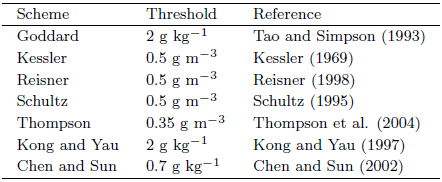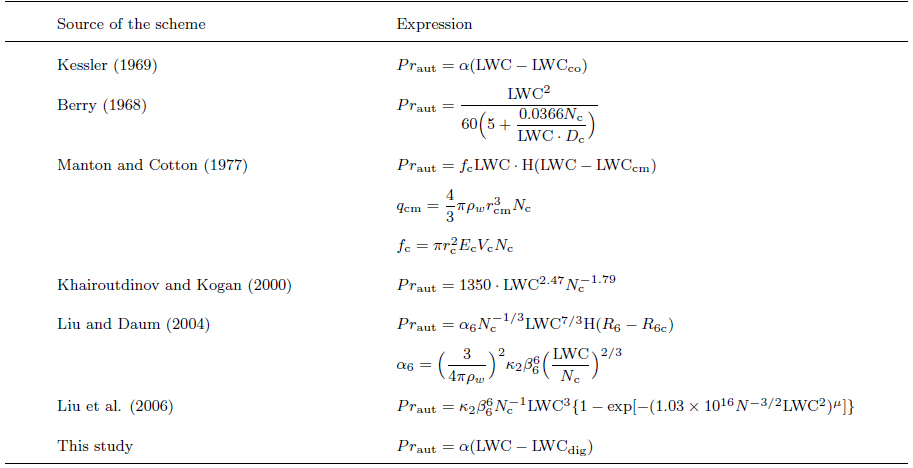The Chinese Meteorological Society
Article Information
- YIN Jinfang, WANG Donghai, ZHAI Guoqing. 2015.
- An Attempt to Improve Kessler-Type Parameterization of Warm Cloud Microphysical Conversion Processes Using CloudSat Observations
- J. Meteor. Res., 29(1): 82-92
- http://dx.doi.org/10.1007/s13351-015-4091-1
-
Article History
- Received 2014-9-2
- in final form 2014-11-4
2 Department of Earth Science, Zhejiang University, Hangzhou 310027
Autoconversion plays a fundamental role in theformation of raindrops in warm clouds, and the formationof raindrops determines the onset of precipitation.Accurate parameterization of autoconversionprocesses in numerical models is an important steptoward improving the underst and ing of aerosol-cloudprecipitationinteractions(Gettelman et al., 2013; Xie and Liu, 2014). In particular,climate models requirereliable parameterization of autoconversion to accuratelysimulate the aerosol indirect effect and its influenceon climate(Rotstayn and Liu, 2005; Guo et al., 2008; Hsieh et al., 2009), and high-resolution numericalweather prediction models require detailed representationof cloud microphysics(including autoconversion)to produce accurate forecasts of precipitation(Fritsch and Carbone, 2004; Franklin,2008).
Considerable effort has been devoted to developingincreasingly accurate parameterization of autoconversionover the past several decades. Kessler(1969)initially proposed a simple parameterization schemethat related the autoconversion rate to cloud liquidwater content(LWC). This scheme has been widelyused in representation of clouds and cloud-related processesin models(e.g.,Rutledge and Hobbs, 1984;Dudhia,1989; Chen and Sun, 2002). Berry(1968)developed an alternate parameterization of autocon-version that incorporated not only LWC but also thecloud droplet number concentration and the spectralshape of cloud droplet size distribution. Thisparameterization focused on estimating the time requiredfor the sixth-moment diameter of the spectraldensity to reach 80 μm under droplet coalescence.Simpson and Wiggert(1969)suggested increasing thissixth-moment diameter threshold to 100 μm. Cotton(1972)repeated Berry(1968)numerical experiments and showed that Berry’s formulation underestimatedrainfall. A certain amount of time is required beforethe droplet population broadens to the extent thatrapid conversion takes place. Cotton(1972)suggestedthat the autoconversion rate could be parameterizedas a function of LWC with an additional dependenceon the “age” of each rising parcel. However,the estimationof Lagrangian timescales for individual dropletpopulations in multi-dimensional models is both challenging and computationally expensive(Manton and Cotton, 1977). Manton and Cotton(1977)proposed aparameterization scheme of autoconversion that coulddifferentiate among air masses while retaining the simplicityof the Kessler formulation. Ghosh and Jonas(1999)combined the advantages of the Kessler and Berry schemes,calculating the autoconversion coefficientas a function of droplet number density and droplet dispersion using the Berry(1968)scheme and the autoconversion threshold using a modified versionof the Kessler(1969)scheme. This approach permitsthe use of the simple linear Kessler formula in largeeddy simulations(LES)while also incorporating theeffects of different cloud types. Model-derived empiricalparameterizations based on bin-microphysicalsimulations have been proposed by Berry and Reinhardt(1974),Khairoutdinov and Kogan(2000), and Franklin(2008). Recent efforts to update autoconversionparameterization have begun to account for theeffects of turbulence on in-cloud droplet collision rates(CarrioÓ and Levi,1995; Franklin,2008; Seifert et al., 2010).
The autoconversion parameterization schemes introducedabove are all based on the same intrinsicphysical foundation,despite differences in the detailedrepresentation. For example,the Kessler formulationis a linear function of LWC exceeding a threshold value,while the Berry formulation is a roughly cubicfunction of the same. Kessler-type schemes assumethat cloud LWC reaches the threshold value after acertain amount of time, and the conversion of cloudwater to rain water only occurs after the LWC exceedsthat threshold. Berry-type schemes assume asimilar “gestation period” for the sixth-moment diameterof the spectral density to reach the thresholdvalue(80 μm for the Berry scheme; 100 μm for theSimpson-Wiggert scheme). Generally speaking,all ofthe autoconversion parameterization schemes includesome representation of this “gestation age”.
More than 10 autoconversion parameterizationschemes have been proposed(e.g.,Berry,1968;Kessler,1969; Berry and Reinhardt, 1974; Manton and Cotton, 1977; Xu and Wang, 1985; Hu et al., 1987;Beheng,1994; Seifert and Beheng, 2001; Liu et al., 2006; Franklin,2008). These schemes may producesubstantially different autoconversion rates for a givenvalue of LWC,with discrepancies up to several ordersof magnitude(Liu et al., 2006). A number of previousstudies have shown that many of these parameterizationschemes systematically overestimate or underestimatethe autoconversion rate. Cotton(1972)notedthat Kessler(1969)formulation produced large errorsat small LWC,while Berry(1968)formulation consistentlyunderestimated rain formation in the simulatedclouds. Iacobellis and Somerville(2006)showed thatthe Manton-Cotton(1977)parameterization resultedin overestimates of liquid water path(LWP)relative tosatellite and surface-based measurements. Silverman and Glass(1973)reported that peak in-cloud watercontents occurred at lower heights in simulations usingthe Cotton(1972)scheme than in simulations usingthe Kessler(1969),Berry(1968),or Simpson and Wiggert(1969)schemes. To our knowledge,no singleautoconversion parameterization consistently providesreliable results over the wide range of conditions and cloud types observed in the natural world; accordingly,additional effort should be put into continued developmentof autoconversion parameterization techniques.
Previous studies have suggested that the autoconversionthreshold may be height dependent(e.g.,Ghosh and Jonas, 1999). Tisler and Savijarvi(2002)have also shown that rain production by autoconversion in a model may be sensitive to the vertical resolution.It is difficult to conduct field experimentsto determine actual threshold values for autoconversion.Therefore,the autoconversion threshold is typicallybased on a variety of indirect measurements.In late April 2006,the National Aeronautics and Space Administration(NASA)launched the Cloud-Sat satellite,which probes the vertical structure ofclouds and precipitation using a near-nadir millimeterwavelengthradar. CloudSat and other satellite instruments(e.g.,MODIS and CALIPSO)observe approximatelythe same fields of view within minutes, and provide a massive set of orbital(Level 2)cloud dataproducts. Among these,the CloudSat 2B-CWC-ROproduct provides observations of the vertical distributionof LWC in clouds.
This study presents a new approach to diagnosingthe thresholds for autoconversion used in the originalKessler scheme based on a large number of CloudSatobservations. It should be noted that the satelliteobservedcloud water contents manifest the combinedimpacts of autoconversion and a variety of other microphysicalprocesses(condensation,accretion,etc.).We are therefore unable to directly measure autoconversionthresholds,despite the continued developmentof observational instruments and techniques. As aconsequence,threshold values for autoconversion differfrom scheme to scheme because thresholds have beenassigned depending on the specific requirements of thesimulation.
The rest of the paper is organized as follows. Section2 introduces the data and method. Section 3 describesthe improvement of the autoconversion parameterization.Section 4 presents comparisons with otherautoconversion parameterization schemes. Section 5summarizes the results.
2. Data and methodThree st and ard CloudSat data products coveringthe period June 2006 through April 2011 are used inthis study,namely,2B-GEOPROF,2B-CLDCLASS, and 2B-CWC-RO. The 2B-GEOPROF product providesvertical profiles of radar reflectivity and a radarderivedcloud mask. The cloud mask takes values between0 and 40,where values greater than 20 indicatestrong confidence that hydrometeors were detected.The data are therefore screened to eliminate cloudmask values less than 20 to ensure a low false detectionrate(Marchand et al., 2008). Marchand et al.(2008)reported that CloudSat is effectively unable to detecthydrometeors at the lowest vertical radar gate(within1.2 km of the surface)due to surface clutter. Kubar etal.(2011)further showed that surface contaminationcauses CloudSat to miss a large number of relativelythin clouds(cloud depths less than 1 km)within 1.2km of the surface. Accordingly,all data points within2 km above the ground are discarded from this analysis.The 2B-CLDCLASS product provides a precipitationflag(Wang and Sassen, 2001). The 2B-CWC-ROproduct contains retrieved profiles of cloud liquid and ice water content,effective radius, and related quantitiesfor each radar profile taken by the CloudSat CloudProfiling Radar(CPR). The liquid cloud retrieval algorithmis a modification of the method described by Austin and Stephens(2001). The 2B-CWC-RO datahave been widely used to underst and and characterizeregional and global distributions of LWC(e.g.,Lee et al., 2010; Zhong et al., 2010; Yang and Zou, 2012;Zhao et al., 2014) and to evaluate and constrain modelsimulations(e.g.,Li et al., 2011; Jiang et al., 2012).
Numerous studies have identified differences incloud properties over oceans and continents(e.g.,Squires,1958; Miles et al., 2000; Eguchi et al., 2014).Miles et al.(2000)showed that the total number concentrationof cloud particles remained approximatelyconstant with depth in marine clouds,but could varyconsiderably with depth in continental clouds. Dropletnumber concentrations are typically lower in marineclouds than in continental stratus, and the mean and effective diameters of cloud particles in marine stratusare typically larger than those in continental stratus.Eguchi et al.(2014)reported smaller values ofcloud effective radius and larger variances in cloud waterpath in clouds over l and areas than in clouds overthe ocean. We therefore focus only on clouds over l and areas in this study. The geographical study area over20°–50°N,80°–140°E(Fig. 1)is identical to that usedin Yin et al.(2013a). Only CloudSat profiles retrievedwithin this region are selected.
The CloudSat data are processed as follows.First,all CloudSat profiles located within the geographicalregion shown in Fig. 1 are selected. Eachdata point is then checked to determine whether itis cloudy. If the data point is cloudy,it is thenfurther analyzed to determine whether precipitationhas formed using the precipitation flag from the 2BCLDCLASSproduct. The 2B-CLDCLASS precipitationflag indicates maximum reflectivity in a low radargate(Z > –10 dBZ) and significant attenuation ofthe signal due to cloud and precipitation(Wang and Sassen, 2001). Additional details regarding the precipitationidentification algorithm are provided by Wang and Sassen(2001) and the CloudSat Level 2 cloud scenarioclassification product process description documents.The cloudy data points are divided into precipitating and non-precipitating clouds, and profilesof LWC are then analyzed separately for precipitating and non-precipitating clouds. One weakness ofthe 2B-CWC-RO data is that large hydrometeor particlesdominate radar reflectivity values in precipitating and mixed-phase clouds,but the large particlesare not contributing to LWC. In addition,CloudSatproducts use a temperature-based partitioning to estimateLWC profiles in temperature ranges associatedwith mixed-phase clouds. Consequently,the verticalprofiles of LWC may therefore contain some biases relatedto the large hydrometeor particles. Moreover,some assumptions used in the LWC retrieval algorithmmay also lead to the bias in LWC. Nonetheless,Cloud-Sat provides a detailed view of the three-dimensionalstructure of clouds and precipitation from space withextensive temporal and spatial coverage. These dataare tremendously useful for a wide range of meteorologicalapplications,including detailed investigationsof cloud microphysics and the improvement of cloudmicrophysical schemes.
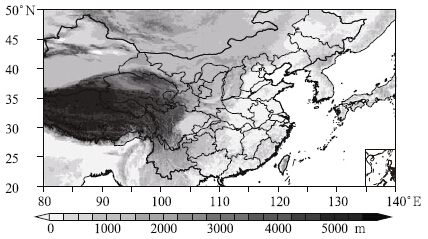 |
| Fig. 1. Geographical coverage of the selected Cloud-Sat data. The grey shading indicates topographic altitude,with ocean areas unshaded. |
Figure 2 shows the typical vertical distributionsof cloud LWC in precipitating and non-precipitatingclouds. The liquid water contents of precipitatingclouds are larger than those of non-precipitatingclouds,especially at low levels. LWC decreases rapidlywith height from lower to upper levels in precipitatingclouds. By contrast,although the mean LWC ofnon-precipitating clouds decreases from 121.5 to 1.1mg m−3 between 5 and 9.6 km,it is approximatelyconstant below 5 km. Very little liquid water existsabove 9.6 km in either type of cloud, and LWC is verylow(less than 50.0 mg m−3)in both types of cloudsbetween 8.4 and 9.6 km. Yin et al.(2013a)reportedthat clouds may reach up to nearly 18 km above sealevel over East Asia,implying that most clouds above9.6 km consist only of ice.
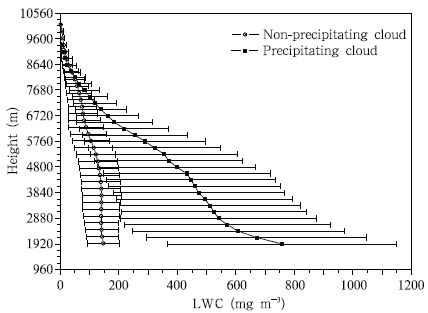 |
| Fig. 2. Vertical distributions of liquid water content(LWC)in precipitating and non-precipitating clouds. Theerror bars indicate the st and ard deviation. |
The mean profile of LWC with height(H)in precipitatingclouds is shown in Fig. 3. An exponential fit to this profile yields the relationship
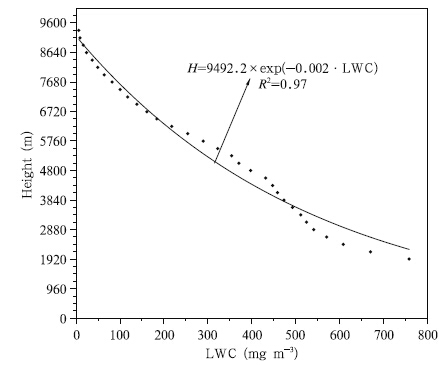 |
| Fig. 3. Mean values of cloud liquid water content(LWC)as a function of height(H)in precipitating clouds. R2is the correlation coefficient between the mean profile and the exponential fit. |
The Kessler-type parameterization scheme cangenerally be written as(Khairoutdinov and Kogan, 2000)
where Praut is the autoconversion rate(in g cm−3s−1)from cloud droplets to raindrops,α(=10−3 s−1)is the empirically-derived conversion coefficient, and LWCco is the threshold liquid water content,belowwhich there is no conversion. The Heaviside step functionH(LWC−LWCco)is used to represent the effectsof the autoconversion threshold LWCco: when LWC< LWCco,H(LWC–LWCco)=0; when LWC ≥ LWCco,H(LWC–LWCco)=1. One of the most arbitrary characteristicsof Kessler(1969)original parameterizationis the choice of LWCco = 0.5 g m−3. Subsequent modificationsof the Kessler scheme have used a numberof different values of LWCco(Table 1). For instance, Schultz(1995) and Reisner et al.(1998)used the samevalue of LWCco as Kessler(1969),while Thompson etal.(2004)proposed a smaller value(0.35 g m−3). Tao and Simpson(1993) and Kong and Yau(1997)used athreshold mass mixing ratio of 2 g kg−1,while Chen and Sun(2002)used a smaller value of 0.7 g kg−1.LWC is frequently expressed as the mass mixing ratioof cloud water in models, and transformation betweenLWC and mass mixing ratio is straightforward(LWCis the product of cloud mass mixing ratio and air density).
As mentioned above,it is difficult to identify reasonablevalues of LWCco that can be generally appliedto different types of clouds. In addition,the assumptionthat the value of LWCco is constant with height(a common assumption in all Kessler-type parameterizationschemes)could prevent the formation of rainin the upper levels of clouds,where LWC may be relativelylow. This assumption delays the formation ofprecipitation and leaves excess LWC at upper levelsin the form of cloud water,which in turn affects theradiation budget(Vaillancourt et al., 2000). For instance,Kessler’s original value of LWCco effectivelyeliminates autoconversion in stratocumulus and stratiformclouds,where LWC rarely exceeds 0.5 g m−3(e.g.,Deng et al., 2009; Hou et al., 2011; Yin et al., 2011,2013b,2014; Zhang et al., 2011; Wood,2012).By contrast,excess conversion of cloud water to rainwater could leave too little cloud water in deep cumulusconvective clouds,where LWC is much higher than 0.5 g m−3(Hu,1979; Kochtubajda,1995; Wolde and Vali, 2002). These limitations of Kessler-type parameterizationmay be overcome by using CloudSatobservations of the vertical distribution of cloud LWCto derive a height-dependent threshold,as proposed inSection 3.3.
3.3 Development of the new parameterizationAs discussed in Section 3.2,the constant thresholdvalue for autoconversion used in traditionalKessler-type parameterization introduces a number oflimitations. These limitations include the diagnosis ofidentical autoconversion rates at different heights withidentical LWCs. Autoconversion rates may be underestimatedwhen LWC is low, and overestimated whenLWC is large. A more precise treatment of autoconversionis therefore necessary.
The new parameterization follows that of Kessler(1969). The autoconversion rate is estimated as
where the value of α(=10−3 s−1)is the same as thatused by Kessler. Equation(3)is the same as Eq.(2)except that the autoconversion threshold LWCdigvaries with height. The height-dependent thresholdLWCdig is estimated based on Eq.(1):
where LWCdig decreases with increasing H.
The estimated autoconversion rates based on Eqs.(3) and (4)are shown as a function of LWC and Hin Fig. 4. The introduction of the height-dependentLWC,i.e.,LWCdig,means that autoconversion ratesat a given LWC also vary with height. Autoconversionis initiated at relatively low values of LWC atupper levels,which permits autoconversion in cloudswith low LWC. The value of LWCdig at levels below2 km is assumed to be equal to the value at H = 2km because CloudSat measurements below 2 km areoften contaminated by surface clutter(Marchand et al., 2008). CloudSat also rarely observes liquid waterabove 9.6 km. The value of LWCdig at levels above9.2 km is therefore assumed to be equal to the valueat 9.2 km. Note that Eq.(4)yields unphysical negativevalues for heights greater than 9492.2 m.
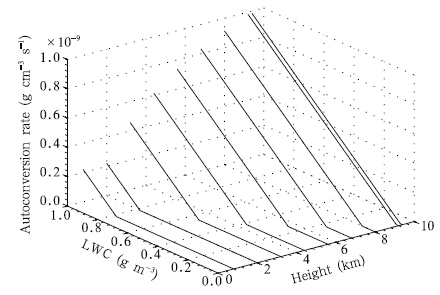 |
| Fig. 4. Autoconversion rates as a function of LWC and height. |
The new autoconversion parameterization schemedescribed in Section 3.3 is compared with severalparameterization schemes mentioned above. Theseschemes and their associated major parameters arelisted in Table 2. Following Ghosh and Jonas(1999) and Iacobellis and Somerville(2006),the cloud dropletnumber concentration(Nc)is set to 200 cm−3. Estimationsof autoconversion rate using the parameterizationscheme of Liu and Daum(2004) and Liu etal.(2006)use a relative dispersion of 0.50. The relativedispersion in the Berry scheme is set to 0.146,following the value used by Ghosh and Jonas(1999)for continental areas. The Manton and Cotton(1977)scheme assumes an average collection efficiency(Ec)associated with autoconversion of 0.55 and a mean radius(rcm)of 10 μm. LWC is expressed as mass mixingratio in g kg−1 in the Khairoutdinov and Kogan(2000)scheme,which is converted to g m−3 by assuming fixedair density of 1.29 × 10−3 g cm−3. The familiar form ofthe Manton and Cotton(1977)parameterization hasbeen given by Liu and Daum(2004; their Eq.(17b)).Following Liu et al.(2006),the parameter μ is set to4 in this study.
Figure 5 shows the height and LWC dependenceof autoconversion rates estimated by using the parameterizationschemes listed in Table 2. Autoconversionrates are calculated over a wide range of LWCs from0.01 to 1.0 g m−3. Despite significant discrepancies among the different estimates,all of the schemes yieldautoconversion rates on the order of approximately10−9 g cm−3 s−1. The Berry(1968) and Khairoutdinov and Kogan(2000)schemes indicate that conversionoccurs when LWC is greater than 0 and the autoconversionrate increases with increasing LWC. Allof the other schemes assume that conversion of cloudwater to rain water only occurs when LWC exceeds athreshold value.
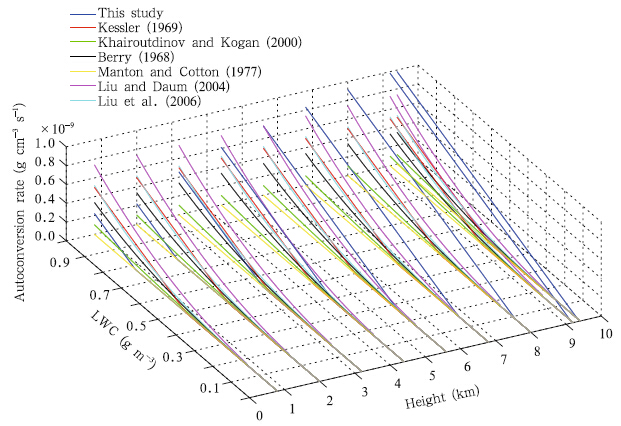 |
| Fig. 5. Autoconversion rates estimated by using the new parameterization,the Kessler(1969)scheme,the Berry(1968)scheme,the Manton and Cotton(1977)scheme,the Khairoutdinov and Kogan(2000)scheme,the Liu and Daum(2004)scheme, and the Liu et al.(2006)scheme(see text for details). |
The Liu and Daum(2004)scheme simulates the largest autoconversion rates below 4.4 km for LWCsbetween 0.01 and 1.0 g m−3,while the new schemesimulates the largest autoconversion rates above 5.6km. Estimates based on the new scheme are similarto those based on the Liu and Daum(2004)schemenear 4.4-km altitude. Wood and Blossey(2005)arguedthat the autoconversion rate estimated by Liu and Daum(2004)represented the total rate of masscoalescence among cloud droplets, and was thereforesubstantially larger than the true autoconversion rate.However,the new parameterization yields larger autoconversionrates for a different reason; namely,thethreshold value of LWC is smaller at levels above 5.6km. Analysis of the CloudSat observations indicatesthat precipitation at these upper levels is associatedwith lower LWCs. The Manton and Cotton(1977)scheme yields the lowest autoconversion rates,followedby the Khairoutdinov and Kogan(2000)scheme. Thenew scheme and the Kessler scheme estimate similarautoconversion rates near 3.2-km altitude. The comparisonspresented here are limited to the formulaelisted in Table 2. A follow-up study will assess theresults of numerical simulations by a single columnmodel or a cloud-resolving model(CRM)to evaluatethe effects of the new parameterization on simulationsof precipitation,cloud properties, and radiation.
5. Conclusions and discussion
The vertical distributions of LWC in precipitating and non-precipitating clouds have been analyzedbased on a large number of CloudSat observationsover Asian l and areas between June 2006 and April2011. The results of this analysis have been used topropose a new definition of the threshold value forKessler-type parameterization of warm cloud autoconversion.One of the novel features of this approachis that the threshold is diagnosed as a function ofheight above mean sea level H. The relationship betweenthe threshold value LWCdig and H is defined asLWCdig = −500.0 × ln . The use of thresholdvalues based on the relationship between LWC and H allows autoconversion to occur at the lower valuesof LWC typical of upper levels in the troposphere. This change increases the formation of precipitationat upper levels and reduces the fraction of LWC thatremains as cloud water. Autoconversion rates estimatedby using the new parameterization have beencompared to those estimated from several commonlyused parameterization schemes over a wide range ofLWCs(0.01–1.0 g m−3). The results show that thenew scheme provides reasonable estimates of autoconversionthroughout the troposphere. In particular,estimatesbased on the new parameterization are similarto those based on the Kessler scheme near 3.2-km altitude and are similar to those based on the Liu and Daum(2004)scheme near 4.4-km altitude. The newparameterization also permits autoconversion at lowerLWCs(less than 0.3 g m−3)above 5.6-km altitude,unlikethe other evaluated parameterization schemes.
. The use of thresholdvalues based on the relationship between LWC and H allows autoconversion to occur at the lower valuesof LWC typical of upper levels in the troposphere. This change increases the formation of precipitationat upper levels and reduces the fraction of LWC thatremains as cloud water. Autoconversion rates estimatedby using the new parameterization have beencompared to those estimated from several commonlyused parameterization schemes over a wide range ofLWCs(0.01–1.0 g m−3). The results show that thenew scheme provides reasonable estimates of autoconversionthroughout the troposphere. In particular,estimatesbased on the new parameterization are similarto those based on the Kessler scheme near 3.2-km altitude and are similar to those based on the Liu and Daum(2004)scheme near 4.4-km altitude. The newparameterization also permits autoconversion at lowerLWCs(less than 0.3 g m−3)above 5.6-km altitude,unlikethe other evaluated parameterization schemes.
Satellite observations of cloud water content areunable to distinguish the effects of various processes(such as autoconversion,condensation, and accretion,among others). The threshold values for autoconversionestimated in this study may therefore be slightlylarger than the true threshold values,which would leadto overestimates of cloud LWC and underestimates ofrainfall in model simulations(Ghosh and Jonas, 1999).This study is also unable to use data below 2 km due tocontamination from surface clutter. Future work willexplore the potential of using the CloudSat 2B-CWCRVODproduct to estimate LWCdig below 2 km. The2B-CWC-RVOD product should provide more reliableestimates of LWC near the surface because it uses opticaldepth as an additional constraint. Despite theuncertainties associated with CloudSat observations,this dataset has become an invaluable tool for exploringthe vertical structure of clouds and precipitation.Observations from CloudSat and other A-Train sensorsoffer a unique global perspective on the joint distributionsof clouds and precipitation(Stephens et al., 2008). Future work will also explore the effects of usingthe autoconversion scheme proposed in this paperin model simulations of idealized and real cases(e.g.,Skamarock et al., 2008; Tao et al., 2014). Particularattention will be paid as to how the proposed schemeaffects model simulations of precipitation,cloud properties, and radiation.
Acknowledgments.The CloudSat data aremade available via the CloudSat Data ProcessingCenter(DPC)managed by the Cooperative Institutefor Research in the Atmosphere(CIRA)at ColoradoState University. The authors are grateful to twoanonymous reviewers for their helpful comments and suggestions that have improved the quality of the paper.
| [1] | Austin, R. T., and G. L. Stephens, 2001: Retrieval of stratus cloud microphysical parameters using millimeter-wave radar and visible optical depth in preparation for CloudSat. 1: Algorithm formula-tion. J. Geophys. Res., 106, 28233-28242. |
| [2] | Beheng, K. D., 1994: A parameterization of warm cloud microphysical conversion processes. Atmos. Res.,33, 193-206. |
| [3] | Berry, E. X., 1968: Modification of the warm rain pro-cess. Preprints, First National Conf. on Weather Modification, Albany, NY, Amer. Meteor. Soc.,81-88. |
| [4] | Berry, E. X., and R. L. Reinhardt, 1974: An analysis of cloud drop growth by collection. Part II: Single initial distributions. J. Atmos. Sci., 31, 1825-1831. |
| [5] | Carrioo, G. G., and L. Levi, 1995: On the parame-terization of autoconversion: Effects of small-scale turbulent motions. Atmos. Res., 38, 21-27. |
| [6] | Chen, S.-H., and W.-Y. Sun, 2002: A one-dimensional time dependent cloud model. J. Meteor. Soc. Japan, 80, 99-118. |
| [7] | Cotton, W. R., 1972: Numerical simulation of precipi-tation development in supercooled cumuli—Part I. Mon. Wea. Rev., 100, 757-763. |
| [8] | Deng, Z. Z., C. S. Zhao, Q. Zhang, et al., 2009: Sta-tistical analysis of microphysical properties and the parameterization of effective radius of warm clouds in Beijing area. Atmos. Res., 93, 888-896. |
| [9] | Dudhia, J., 1989: Numerical study of convection ob-served during the winter monsoon experiment using a mesoscale two-dimensional model. J. Atmos. Sci.,46, 3077-3107. |
| [10] | Eguchi, N., T. Hayasaka, and M. Sawada, 2014: Maritime-continental contrasts in the properties of low-level clouds: A case study of the summer of the 2003 Yamase, Japan, cloud event. Adv. Meteor.,548091, doi: 10.1155/2014/548091. |
| [11] | Franklin, C. N., 2008: A warm rain microphysics param-eterization that includes the effect of turbulence. J. Atmos. Sci., 65, 1795-1816. |
| [12] | Fritsch, J. M., and R. E. Carbone, 2004: Improving quan-titative precipitation forecasts in the warm season, A USWRP research and development strategy. Bull. Amer. Meteor. Soc., 85, 955-965. |
| [13] | Gettelman, A., H. Morrison, C. R. Terai, et al., 2013: Microphysical process rates and global aerosol-cloud interactions. Atmos. Chem. Phys., 13, 9855-9867. |
| [14] | Ghosh, S., and P. R. Jonas, 1999: On the application of the classic Kessler and Berry schemes in large eddy simulation models with a particular emphasis on cloud autoconversion, the onset time of precipi-tation and droplet evaporation. Ann. Geophys., 16,628-637. |
| [15] | Guo, H., Y. Liu, and J. E. Penner, 2008: Does the threshold representation associated with the auto-conversion process matter? Atmos. Chem. Phys.,8, 1225-1230. |
| [16] | Hou Tuanjie, Hu Zhaoxia, and Lei Hengchi, 2011: A study of the structure and microphysical processes of a precipitating stratiform cloud in Jilin. Acta Meteor. Sinica, 69, 508-520. (in Chinese) |
| [17] | Hsieh, W. C., H. Jonsson, L. P. Wang, et al., 2009: On the representation of droplet coalescence and auto-conversion, evaluation using ambient cloud droplet size distributions. J. Geophys. Res., 114. doi:10.1029/2008JD010502 |
| [18] | Hu Zhijin, 1979: On the conditions of warm rain forma-tion in cumulus clouds. Acta Meteor. Sinica, 37, 72-79. (in Chinese) |
| [19] | Hu Zhijin, Yan Caifan, and Wang Yubin, 1987: Numeri-cal simulation of rain and seeding processes in warm layer clouds. Acta Meteor. Sinica, 41, 79-88. (in Chinese) |
| [20] | Iacobellis, S. F., and R. C. J. Somerville, 2006: Eval-uating parameterizations of the autoconversion process using a single-column model and atmo-spheric radiation measurement program measure-ments. J. Geophys. Res., 111, D02203, doi:10.1029/2005JD006296. |
| [21] | Jiang, J. H., H. Su, C. X. Zhai, et al., 2012: Evalua-tion of cloud and water vapor simulations in CMIP5 climate models using NASA “A-Train” satellite ob-servations. J. Geophys. Res., 117, D14105, doi:10.1029/2011JD017237. |
| [22] | Kessler, E., 1969: On the Distribution and Continuity of Water Substance in Atmospheric Circulations. Boston, Meteorological Monographs, Amer. Me-teor. Soc., 10 pp. |
| [23] | Khairoutdinov, M., and Y. Kogan, 2000: A new cloud physics parameterization in a large-eddy simulation model of marine stratocumulus. Mon. Wea. Rev.,128, 229-243. |
| [24] | Kochtubajda, B., 1995: The microstructure of selected, small, isolated, cumulus clouds near Red Deer, Al-berta. Atmos. Res., 35, 253-270. |
| [25] | Kong, F., and M. K. Yau, 1997: An explicit approach to microphysics in MC2. Atmosphere-Ocean, 35,257-291. |
| [26] | Kubar, T. L., E. W. Duane, and J.-L. Li, 2011: Bound-ary layer and cloud structure controls on tropical low cloud cover using A-Train satellite data and ECMWF analyses. J. Climate, 24, 194-215. |
| [27] | Lee, S., B. H. Kahn, and J. Teixeira, 2010: Character-ization of cloud liquid water content distributions from CloudSat. J. Geophys. Res., 115, D20203, doi: 10.1029/2009JD013272. |
| [28] | Li, J.-L. F., D. E. Waliser, and C. Wood, et al., 2011: Comparisons of satellites liquid water estimates to ECMWF and GMAO analyses, 20th century IPCC AR4 climate simulations, and GCM simu-lations. Geophys. Res. Lett., 38, L24807, doi:10.1029/2011GL049956. |
| [29] | Liu, Y. G., and P. H. Daum, 2004: Parameterization of the autoconversion process. Part I: Analytical formulation of the Kessler-type parameterizations. J. Atmos. Sci., 61, 1539-1548. |
| [30] | Liu, Y. G., P. H. Daum, R. McGraw, et al., 2006: Param-eterization of the autoconversion process. Part II: Generalization of Sundqvist-type parameterizations. J. Atmos. Sci., 63, 1103-1109. |
| [31] | Manton, M. L., and W. R. Cotton, 1977: Formulation of approximate equations for modeling moist deep convection on the mesoscale. Ph. D. dissertation, Atmospheric Science, Colorado State University, 62 pp. |
| [32] | Marchand, R., G. G. Mace, T. Ackerman, et al., 2008: Hydrometeor detection using Cloudsat—An earth-orbiting 94-GHz cloud radar. J. Atmos. Ocea. Tech., 25, 519-533. |
| [33] | Miles, N. L., J. Verlinde, and E. E. Clothiaux, 2000: Cloud droplet size distributions in low-level strati-form clouds. J. Atmos. Sci., 57, 295-311. |
| [34] | Reisner, J., R. M. Rasmussen, and R. T. Bruintjes, 1998: Explicit forecasting of supercooled liquid water in winter storms using the MM5 mesoscale model. Quart. J. Roy. Meteor. Soc., 124, 1071-1107. |
| [35] | Rotstayn, L. D., and Y. G. Liu, 2005: A smaller global es-timate of the second indirect aerosol effect. Geophys. Res. Lett., 32, L05708, doi: 10.1029/2004GL021922. |
| [36] | Rutledge, S. A., and P. V. Hobbs, 1984: The mesoscale and microscale structure and organization of clouds and precipitation in midlatitude cyclones. XII: A diagnostic modeling study of precipitation develop-ment in narrow cold-frontal rainbands. J. Atmos. Sci., 41, 2949-2972. |
| [37] | Schultz, P., 1995: An explicit cloud physics parameteri-zation for operational numerical weather prediction. Mon. Wea. Rev., 123, 3331-3343. |
| [38] | Seifert, A., and K. D. Beheng, 2001: A double-moment parameterization for simulating autoconversion, ac-cretion, and selfcollection. Atmos. Res., 59, 265-281. |
| [39] | Seifert, A., L. Nuijens, and B. Stevens, 2010: Turbulence effects on warm-rain autoconversion in precipitating shallow convection. Quart. J. Roy. Meteor. Soc.,136, 1753-1762. |
| [40] | Silverman, B. A., and M. Glass, 1973: A numerical sim-ulation of warm cumulus clouds: Part I. Parameter-ized vs non-parameterized microphysics. J. Atmos. Sci., 30, 1620-1637. |
| [41] | Simpson, J., and V. Wiggert, 1969: Models of precipitat-ing cumulus towers. Mon. Wea. Rev., 97, 471-489. |
| [42] | Skamarock, W. C., J. B. Klemp, J. Dudhia, et al., 2008: A Description of the Advanced Re-search WRF version 3. Boulder, Colorado, USA.http://www2.mmm.ucar.edu/wrf/users/docs/. |
| [43] | Squires, P., 1958: The microstructure and colloidal sta-bility of warm clouds. Part I: The relation between structure and stability. Tellus, 10, 256-261. |
| [44] | Stephens, G. L., D. G. Vane, S. Tanelli, et al., 2008: CloudSat mission: Performance and early science after the first year of operation. J. Geophys. Res.,113, D00A18, doi: 10.1029/2008JD009982. |
| [45] | Tao, W.-K., and J. Simpson, 1993: The Goddard Cu-mulus Ensemble model. Part I: Model description. Terr. Atmos. Oceanic Sci., 4, 35-72. |
| [46] | Tao, W.-K., S. Lang, X. Zeng, et al., 2014: The God-dard Cumulus Ensemble model (GCE): Improve-ments and applications for studying precipitation processes. Atmos. Res., 143, 392-424. |
| [47] | Thompson, G., R. M. Rasmussen, and K. Manning, 2004: Explicit forecasts of winter precipitation us-ing an improved bulk microphysics scheme. Part I: Description and sensitivity analysis. Mon. Wea. Rev., 132, 519-542. |
| [48] | Tisler, P., and H. Savijarvi, 2002: On the parameterization of precipitation in warm clouds. Atmos. Res.,63, 163-176. |
| [49] | Vaillancourt, P. A., A. Tremblay, S. G. Cober, et al. 2000: Evaluation of a mixed-phase cloud scheme’s ability of forecasting supercooled liquid water in clouds. Proc. 13th Int. Conf. Clouds and Precip, Reno, NV, 14-18 August, Amer. Meteor. Soc., 586-589. |
| [50] | Wang, Z., and K. Sassen, 2001: Cloud type and macrophysical property retrieval using multiple remote sensors. J. Appl. Meteor., 40, 1665-1682. |
| [51] | Wolde, M., and G. Vali, 2002: Cloud structure and crystal growth in nimbostratus. Atmos. Res., 61, 49-74. |
| [52] | Wood, R., and P. N. Blossey, 2005: Comments on “Parameterization of the autoconversion process. Part I: Analytical formulation of the Kessler-type parameterizations.” J. Atmos. Sci., 62, 3003-3006. |
| [53] | Wood, R., 2012: Stratocumulus clouds. Mon. Wea.Rev., 140, 2373-2423. |
| [54] | Xie Xiaoning and Liu Xiaodong, 2015: Aerosol-cloud-precipitation interactions in WRF model: Sensitiv-ity to autoconversion parameterization. J. Meteor. Res., 29, 72-81, doi: 10.1007/s13351-014-4065-8. |
| [55] | Xu Huanbin and Wang Siwei, 1985: A numerical model of hail-bearing convective cloud (I): Biparameter evolution of size distribution of raindrops, frozen raindrops, and hailstones. Acta Meteor. Sinica, 43,13-25. (in Chinese) |
| [56] | Yang, S., and X. Zou, 2012: Assessments of cloud liq-uid water contributions to GPS radio occultation refractivity using measurements from COSMIC and CloudSat. J. Geophys. Res., 117, D06219, doi:10.1029/2011JD016452. |
| [57] | Yin, J. F., D. H. Wang, and G. Q. Zhai, 2011: Long-term in-situ measurements of the cloud-precipitation mi-crophysical properties over East Asia. Atmos. Res.,102, 206-217. |
| [58] | Yin Jinfang, Wang Donghai, Zhai Guoqing, et al., 2013a: Observational characteristics of cloud vertical pro-files over the continent of East Asia from the Cloud-Sat data. Acta Meteor. Sinica, 27, 26-39. |
| [59] | Yin, J. F., D. H. Wang, and G. Q. Zhai, 2013b: A com-parative study of cloud-precipitation microphysical properties between East Asia and other regions. J. Meteor. Soc. Japan, 91, 507-526. |
| [60] | Yin, J. F., D. H. Wang, G. Q. Zhai, et al., 2014: An investigation into liquid water content versus cloud number concentration in the stratiform clouds over North China. Atmos. Res., 139, 137-143. |
| [61] | Zhang Dianguo, Guo Xueliang, Gong Dianli, et al., 2011: The observational results of the clouds microphysical structure based on the data obtained by 23 sorties between 1989 and 2008 in Shandong Province. Acta Meteor. Sinica, 69, 195-207. (in Chinese) |
| [62] | Zhao Yanfeng, Wang Donghai, and Yin Jinfang, 2014: A study on cloud microphysical characteristics over the Tibetan Plateau using CloudSat data. J. Trop. Meteor., 30, 239-248. (in Chinese) |
| [63] | Zhong Lingzhi, Liu Liping, Chen Lin, et al., 2010: A po-tential application of a millimeter wavelength radar to studying the cloud physics mechanism for ice and snow weather. Acta Meteor. Sinica, 68, 705-716. (in Chinese) |
 2015, Vol. 29
2015, Vol. 29





